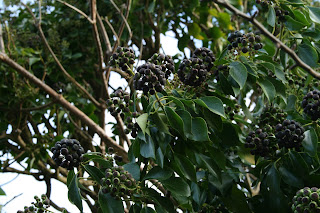We love to add Blackbird to our list of singing birds about the garden.. They are so melodic and the song has a lovely tempo; they typically sing in late afternoon and in the evening, their song is another reminder that the light stretches until well after six oclock now: At the other end of the day, i.e. dawn, a full twelve hours earlier, the Song Thrushes are waking me up, with their loud and much more urgent song..
 |
| Blackbirds: song is a sure sign of spring |
This is the last week of the Garden Bird Survey, nothing really new to report except that I think that our garden bird populations will have survived the winter quite nicely. They will benefit from the mild winter season just passing, after three hard ones, and from the food we provide as they set up territories for the nesting season.
Elsewhere around the garden, I have been disturbing Wood Pigeons from the odd Elder or Hawthorn tree: hidden in the mop of Ivy thereon..
 |
| Wood Pigeon in a stand of Ivy |
 |
| Balls of black Ivy berries |
After last weeks inspiring visit to Altamont, it was back to home turf to assess options: always easier when the weather has been so dry and sunny: Vegetable beds were cleared of weeds and compost added, ready now for first spring planting of Shallots; seed onions and potatoes can wait another couple of weeks.
 |
| Pulmonaria: star performer! |
Enjoy the great weather, long may it last..











